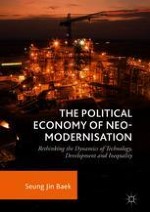2018 | OriginalPaper | Chapter
5. Theoretical Reshaping for the Augmented Inequality Dynamics
Author : Seung Jin Baek
Published in: The Political Economy of Neo-modernisation
Publisher: Springer International Publishing
Activate our intelligent search to find suitable subject content or patents.
Select sections of text to find matching patents with Artificial Intelligence. powered by
Select sections of text to find additional relevant content using AI-assisted search. powered by
